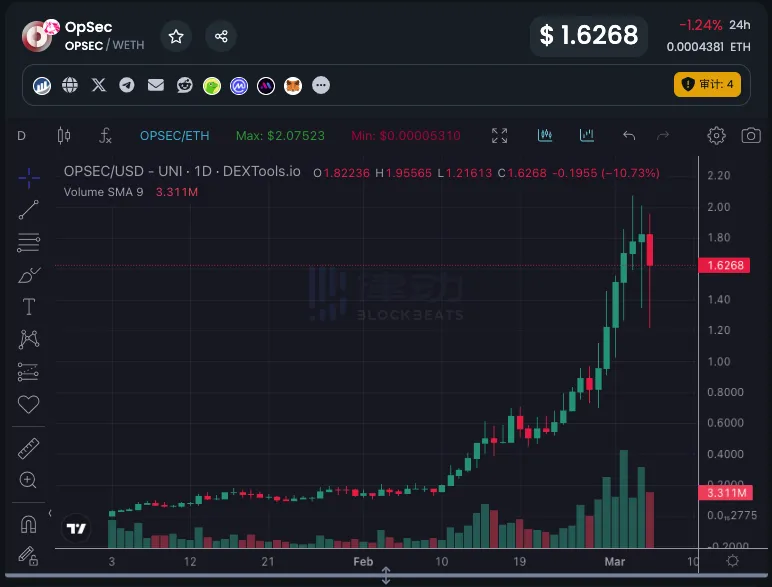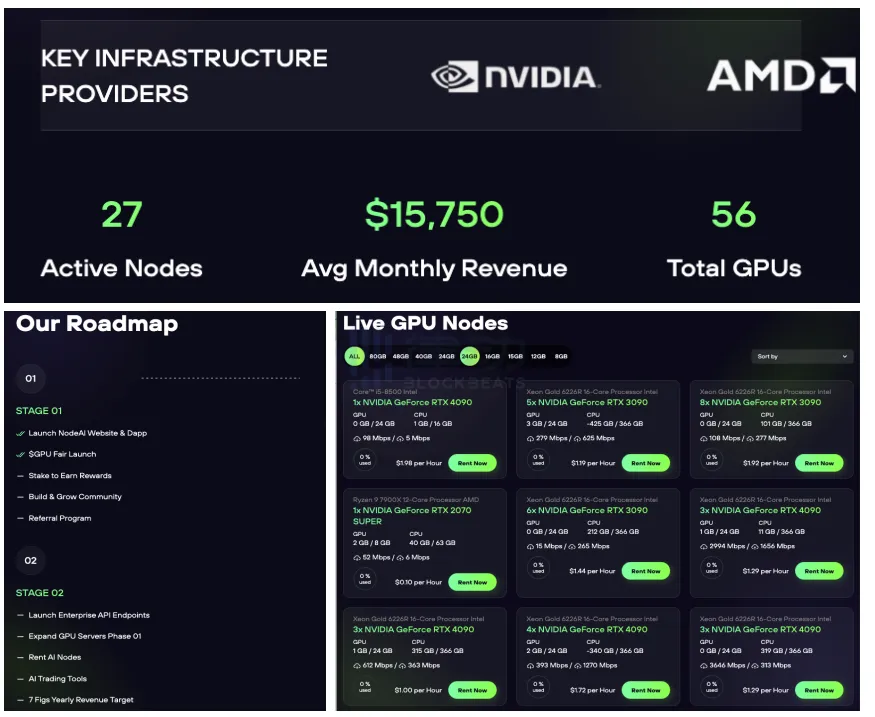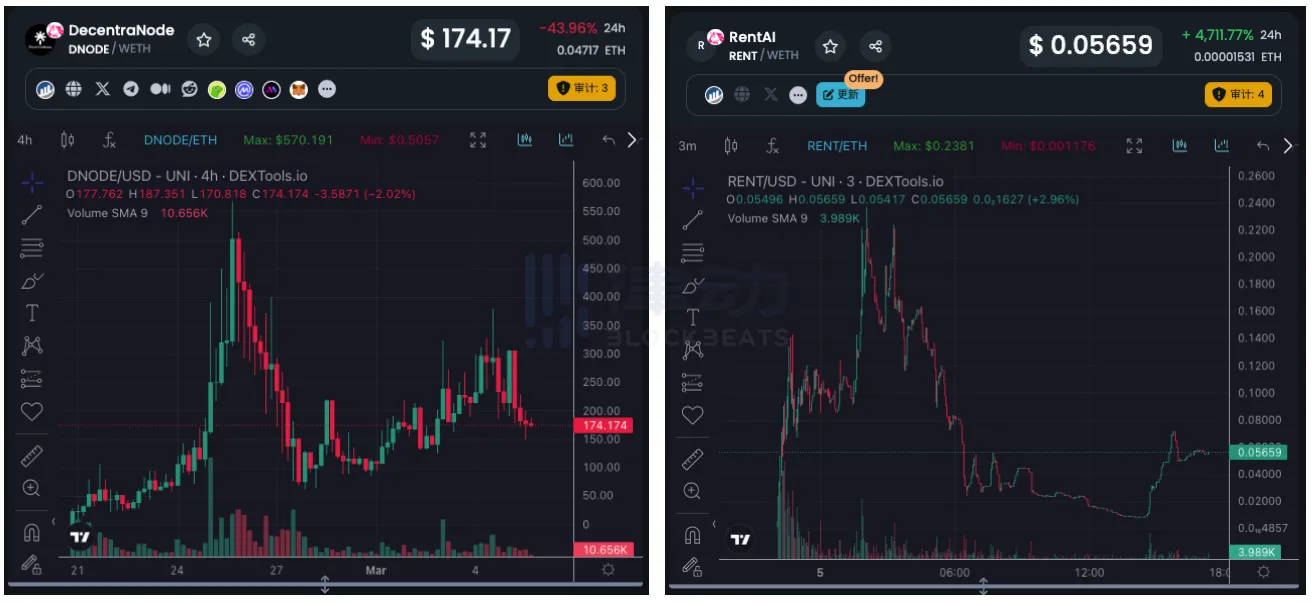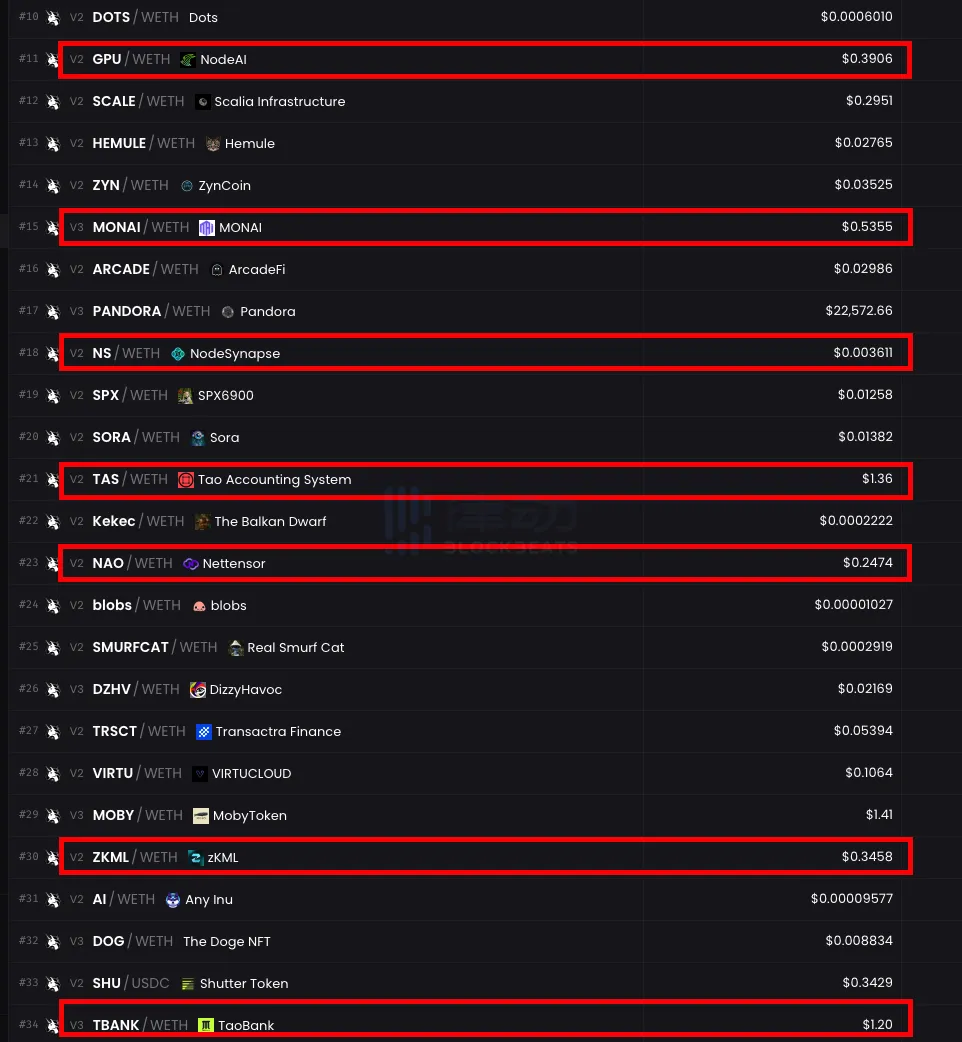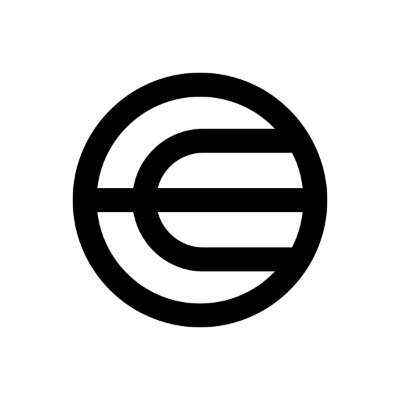What is the catalyst driving the soaring prices in the rapidly ascending AI sector?
Author: Joyce, BlockBeats
Editor: Jack, BlockBeats
After a week of consolidation, the AI sector has taken off again. From the perspective of nearly half a year, the tokens of various projects in the AI sector have continued to rise, with tokens like WLD, RNDR, AGIX, and FET experiencing several-fold increases. In the month since early February, many new projects in the AI sector have seen their tokens rise more than five times, or even dozens of times, in less than two weeks. Why has the AI sector been able to flourish and show sustained and strong growth? What are the new projects with obvious wealth effects? How does the once-perceived complex AI narrative support the emergence of these new projects? BlockBeats discusses these questions in this article.
Who is Driving the AI Sector?
Crypto VCs Keep Promoting
Echoing the Web2 world, "AI" has become a keyword frequently appearing in the annual outlook articles of major investment institutions by the end of 2023. As Messari wrote in its 2024 investment forecast, "AI has become the new darling of the tech field. We have once again become bystanders."
Tommy, co-founder of Delphi Digital, which has invested in 14 AI x Crypto projects, has stated, "I believe we are moving towards a world with billions of AI models, whether everyone downloads and personalizes these open-source models or projects and companies build their own model sets for specific use cases (such as providing Uniswap LP, exchange risk analysis, Delphi AI analysts)."
In-depth research on the AI sector is also underway. Vitalik wrote in January this year about the prospects and challenges of Crypto+AI applications, while Galaxy Digital analyzed the business models and limitations of representative AI projects. Various signs indicate that the market is very optimistic about the future of the AI sector in 2024.
Signals from "AI Giants"
How should the combination of AI and Web3 be approached? The phrases "AI represents productivity, Web3 represents production relations" and "do Web2 things in a Web3 way" can help understand the stories told by most AI projects emerging in the crypto space. It is evident that to hype the AI sector, the "fire source" lies in traditional AI giants.
Looking back at this year, the heat of the AI sector has remained high without pause, with projects showing impressive gains rising and falling in turn.
On February 16, OpenAI's new AI model Sora made a splash, attracting significant attention in the AI industry. A meme named after Sora appeared on Ethereum, skyrocketing over a thousand times within 12 hours. Following this, OpenAI founder Sam Altman's AI project Worldcoin rose over 300% in two weeks.
NVIDIA chips, which meet computing power demands, remain hot commodities among major companies. In the early hours of February 22, NVIDIA released its fourth-quarter financial report, showing a revenue of $22.1 billion, far exceeding analysts' expectations of $20.4 billion. Reports indicate that NVIDIA's stock has risen 63% in the first two months of the year.
Previously, although the development potential of AI had been recognized, compared to other sectors like DeFi and GameFi, the AI sector often faced "applause without attendance" due to market misunderstanding. However, the emergence of Sora and NVIDIA's strong performance have drawn more attention to the development potential of AI projects, leading to a general rise in the AI sector in early February.
Retail Investors Fear Missing Out, New Projects Capture Heat
Why has the continuous rise of WLD surprised everyone? One possible reason is that most AI projects entering the community's view had already passed the "value discovery" process.
Render Network, a decentralized rendering solution based on GPU, has seen its token RNDR rise over 450% in the past six months, reaching near the highs of its initial coin offering in 2022, with a market cap exceeding $2.7 billion. Fetch.AI, an AI ledger born in 2019, has seen its token rise over 240% in the past 20 days, doubling its previous bull market peak. Other AI sector tokens like AGIX and ARKM have also seen two to three times increases in just two weeks.
Left: RNDR Daily; Middle: FET Weekly; Right: AGIX Daily
The buying willingness in the crypto market has become strong enough, but most AI projects appeared over a year ago. For AI concepts that have not yet undergone value verification and whose use cases remain unclear, the trading mentality of buying new rather than old has deterred some observers.
Thus, whether starting from the tight computing power or telling an attractive story in a Web3 manner, or directly applying AI technology in the Web3 field as Dapps to empower the ecosystem, it seems that as long as the narrative makes sense, even replicating previous project concepts can attract a wave of liquidity driven by anxiety from fear of missing out.
Which AI Projects Are Rising?
It is important to note that, unlike other sectors, the valuation models and pathways of AI are still unclear. Many small-cap AI projects are being early promoted by alpha hunters and successfully attracting liquidity, making it more appropriate to view these projects as "meme with technical narratives."
Currently, newly emerged AI projects have reached around tenfold increases, similar to the trends of AI projects in the last bull market. However, unlike before, influenced by NVIDIA and OpenAI, the attention and expectations for the AI sector in this bull market are greater than ever, so it cannot be simply compared to past bull market curves.
Small Caps Blooming Everywhere
In the AI sector, the easiest and most understandable narrative is in the direction of decentralized computing, where "providing a GPU hardware bilateral market" has become familiar to the market.
Last month, projects focusing on decentralized computing/cloud services under the "GPU sharing model" emerged in clusters, and many have seen good upward trends recently. BlockBeats mentioned the GPU leasing project Node AI ($GPU) in "AI Concept Coins Surge, Have You Invested in These 10 Alpha Projects?" at a price of $0.22. After a week of consolidation, $GPU broke through $0.3 on Monday and subsequently rose to around $1.2.
In addition to Node AI ($GPU), other projects focusing on GPU sharing, such as NetMind.AI ($NMT) and NodeSynapse ($NS), have also shown similar upward trends. Notably, NetMind.AI's official website released specific information about its founding team, all of whom are Chinese.
Left: Node.AI; Middle: NetMind.AI; Right: NodeSynapse
However, GPU leasing services are not a new story in this bull market. Clore.ai ($CLORE), which emerged last year, also had over tenfold increases but did not maintain that peak for long before starting to decline. The AI craze in early February also boosted $CLORE, but it still has not surpassed its previous high.
Founded in 2020, Akash, which focuses on providing a cloud computing market, launched a testnet focused on GPU leasing last year, and its token AKT has risen nearly five times in the past six months. However, this achievement pales in comparison to the newly emerging projects.
TAO Ecosystem
As is well known, the three core elements of AI are data, algorithms, and computing power. Bittensor targets the algorithm direction, building a network architecture connected by many subnetworks, allowing anyone to create subnetworks with custom incentives and different AI model use cases. Currently, TAO's market cap exceeds $4 billion, and its price has been hovering between $600 and $700 for a month. In the short term, TAO may not bring high returns to its holders, while many projects in the Bittensor ecosystem are shining brightly.
OpSec positions itself as a decentralized physical infrastructure network provider on Bittensor, with products including the decentralized project deployment portal OpSecCloud Bot, the proxy OpSecure Mesh, and the RDP product OpSec Cloudverse.
Since OpSec launched its V2 testnet on February 14, its token has entered an upward mode, rising over 150% in nearly a week to reach a peak, and has since pulled back 10%. OpSec continues to update its developments, announcing on March 4 the launch of Cloudverse Epoch 1, which will make it easier for users to deploy nodes, and has also opened a Discord community. According to the team, Cloudverse sold over 500 nodes within 24 hours of its release.
In addition to OpSec, the lending protocol Tao Bank ($TBANK) on the Bittensor network has also appeared in alpha hunters' tweets, and the experimental token standard Tao Accounting System ($TAS) has seen an astonishing sevenfold increase in three days.
AI Project Pipeline: How to Quickly Launch?
The complexity of technology, long construction cycles, and "slow effectiveness" are among the reasons why the AI sector has not been favored in the past. But with so many AI projects emerging in a short time, what is the secret? BlockBeats has found that these early projects share similar "launch" approaches.
Choosing the Most Attractive Narrative
Among the new AI projects that emerged around February, many have positioned themselves in the GPU leasing market. Due to existing successful precedents, the market's buying sentiment is very strong. However, it is still unclear what forces these projects rely on to schedule and utilize the collected computing power resources.
Taking Node.AI (GPU), which has repeatedly broken new highs and risen nearly 20 times in two weeks while still climbing, as an example, although its official website has released the number of active nodes and the prices for leasing different specifications of GPUs, Node.AI has only completed the steps of "launching the NodeAI website and Dapp" and "$GPU Fair Launch."
Previously, some community members pointed out that Node.AI merely provided a Google Sheet to collect customers needing to lease GPU computing power, without any substantial landing plans. Before users can truly provide their computing nodes for lease, several stages such as open token staking and launching invitation plans are still needed.
Not all projects can enjoy sustained glory for several days. The DecentraNode project token ($DENODE), which also introduced GPU leasing services in its white paper, surged over 20 times in just four days after its launch but then dropped over 80% in the following two days.
On March 4, a new GPU leasing project Rent AI announced the launch of its token ($RENT). From its price chart, it can be seen that $RENT surged over 20 times within four hours of its launch but then began to decline, returning to near its initial value 16 hours after its launch. Unlike Node.AI, Rent AI had already opened its token staking channel at the beginning of its launch.
Additionally, GPUBot, which emerged on February 29, allows users to sell and lease CPUs/GPUs on Telegram without KYC, seeing a surge of over 440% in nearly 24 hours, but the number of holding addresses is only around 700.
In addition to GPU leasing services, AI chatbots are also a popular direction for new projects. The AI prediction bot SpectreAI ($SPECTRE) has risen six times in two weeks, while the AI bot project mocai, built on the parallel EVM network Monad, had an LBP price of $0.125. Despite being discovered that its Beta version might just be the ChatGPT API, this did not prevent its token from rising over 360% since its launch four days ago.
NVIDIA Developer Program for Everyone
After launching the official website and white paper, how to attract the community's attention? First and foremost, it is often through mentions by KOLs. "It's an AI project and still in the early stages" is the best selling point. In the early attention lists of some AI projects, familiar alpha hunters can often be found, and there are often bots in the project's TG group monitoring token purchases.
Moreover, BlockBeats has observed that the vast majority of new AI projects announce their participation in the NVIDIA Developer Program and use the phrase "establishing a partnership with NVIDIA."
In reality, the developer program is an initiative by NVIDIA to provide tools, resources, and training for developers, researchers, and students, helping teams develop applications based on NVIDIA technology. Joining the NVIDIA Developer Program does not mean that the project team has "established a partnership with NVIDIA"; the project team only has access to SDK repositories, NVIDIA GPU catalogs, tools, training, and other resources.
Projects that have joined the NVIDIA Developer Program
In addition to the NVIDIA Developer Program, IBM's Elite Program, as well as developer programs from Google and Microsoft, are also mentioned in many AI projects' "partnerships."
Collaborative Efforts
Are project teams taking action? The operational cycle of AI projects often takes a long time. Generally, when the community observes whether a project is reliable, its partnerships often become an important reference indicator. Therefore, it can be seen that some AI projects frequently update their partnership information.
For example, Vault, an L1 blockchain established in 2023, has had eight AI projects collaborate with it within 11 days, including the GPU sharing project MineAI, server hosting project NodeSynapse, AI design tool SyntaxErc, AI prediction bot SpectreAI, GPU leasing service DecentraNode, AI DEX MultiDexAI, AI auditing tool SmartAudit AI, and AI-driven on-chain trading tool SmartMoney.
For AigentX, which is positioned to help Web3 projects customize AI-driven operational solutions, such partnerships can be mutually beneficial. Over the past month and a half, AigentX has announced collaborations with 14 AI concept projects, including NodeSynapse, SmartAudit AI, DecentraNode, SmartMoney, GPU sharing project Blendr Network, AI-driven betting platform BetAI, AI project ShellifyAI, intelligent chatbot VirtuMate, AI trading tool Artemisai, TG tool BuildAI, Bittensor subnet aph5nt, AI trading tool Volumint, decentralized cloud service DeCloud, and GPU leasing project Node.AI.
Conclusion
A large number of AI projects have emerged, becoming regulars in alpha hunters' promotions and on-chain trading hot lists. Some have sustained growth, while others have seen sharp declines the next day.
Who is the leader among AI projects? This is a difficult question to answer. Many people might mention Bittensor (TAO), possibly due to its top ranking in market cap within the AI sector, but Bittensor currently lacks practical use cases, and it is hard to find another AI project doing similar business. How much appreciation potential does Bittensor have? How fast is its development? Without comparable projects, it stands out uniquely in the AI sector.
In the direction of decentralized computing, projects like Render Network, supported by strong traditional giants in the rendering business, are facing formidable competitors like io.net. However, it seems that these projects are currently opening up GPU supply resources to each other, and this direction is still in a phase of mutual support and energy accumulation.
The absence of a clear leader may be the best time to explore wealth effects. Unlike other sectors, DeFi projects can be analyzed based on TVL, chain ecosystems, etc., and the DeFi mechanism itself can be understood by referencing traditional financial models. GameFi can be felt through game studios, economic system design, game development progress, and community ecosystems; but from what angle should an AI project be analyzed?
From a short-term profit perspective, Twitter dynamics, website front-end, white papers, Telegram operations, Discord ecosystems, etc., can all convey whether the project team is "taking action" and how the market's expectations are. To some extent, the logic of chasing early projects is similar to that of chasing memes: looking at market cap, the number of holding addresses, and whether KOLs mention it, being bold yet cautious, and taking profits in time. Based on the trends of already emerged projects, as long as one acts early and withdraws timely, good returns can be achieved.
In the long run, unlike other sectors, the differences among various sub-directions in the AI sector are significant, and they are still exploring. Is decentralized computing AI or DePIN? Besides the shell of GPT, what other stories are there in the application layer? In addition to the numerous AI projects currently viewed as memes, there are also "old" players from the previous round like Bittensor, Render, Arkham, etc., and this round is not without projects like io.net, Scopechat, and Ritual that are continuously building and have high expectations but have not yet issued tokens.
Just last night, Fetch.ai announced the launch of a $100 million infrastructure investment project "Fetch Compute," while io.net announced the completion of a $30 million Series A financing round with participation from star investment institutions like Hack VC and Multicoin Capital. Whether 2024 will usher in an AI summer remains uncertain, but it is certain that the AIxCrypto narrative will become increasingly clear.




